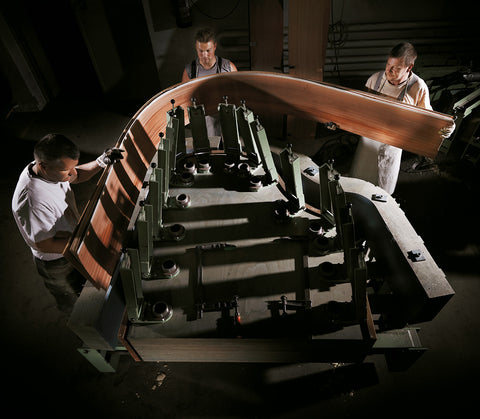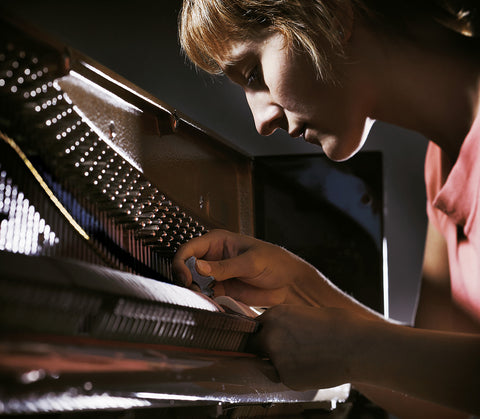Kwaliteit van Europese piano's
De ontwikkeling van de piano en vleugel is voor het overgrote deel een Europese aangelegenheid geweest en nog steeds worden in Europa (met name in Duitsland en Tsjechië) ’s werelds beste piano’s en vleugels gebouwd.
Europese piano’s en vleugels zijn duurzamer en hebben zangbodems die een boventoon- en kleurrijker klankbeeld voortbrengen dan de Aziatische. Ook zijn de Europese piano- en vleugelmechanieken kwalitatief nog steeds onovertroffen, omdat zij stabieler zijn en een grotere dynamische aanstuurbaarheid bieden dan de Aziatische.
Een kleurrijke klank samen met een zo groot mogelijke variatie in hard en zacht (Pianoforte) bepalen de mate waarin de intenties en emoties van de muziek kunnen worden overgedragen.
Het enorme aantal Aziatische instrumenten komt grotendeels voort uit massaproductie terwijl in Europese instrumenten, ook vandaag, zeer veel tijd wordt geïnvesteerd.

De verschillen tussen Europese en Aziatische piano’s en vleugels kunnen zowel op bouwtechnische aspecten als op materiaalkwaliteit en/of materiaalkeuze worden geconstateerd en gecontroleerd.
Zo worden in Europese instrumenten Duitse hamerkoppen gebruikt.
Hamerkoppen liggen aan de basis van iedere klank omdat zij de klank oppakken en de intensiteit ervan via de kam naar de zangbodem aansturen. C. Bechstein bijvoorbeeld, produceert zelfs eigen hamerkoppen voor al haar piano- en vleugelmodellen! Deze zijn van 100 % natuurwol (Wurzen vilt, genaamd naar het stadje Wurzen vlak bij Leipzig) en worden met een lage druk procedé om de mahonie kern gespannen. Het overgrote deel van de in Azië geproduceerde piano’s en vleugels maken daarentegen hamerkoppen met kunstwol, die juist onder hoge druk om de hamerkern worden gespannen en om in een warm klimaat vocht in het hamerkopvilt tegen te houden, worden zij met lak geïmpregneerd. De toon van een piano of vleugel met geïmpregneerde hamers is eenvormiger/eenzijdiger en heeft daardoor minder ziel/karakter en minder intonatie mogelijkheden.
De in Europese instrumenten (C. Bechstein, Steingraeber & Söhne, Fazioli, Steinway, Bösendorfer) gebruikte hoge kwaliteit Renner mechanieken maken gebruik van de modernste CNC (computer numerical control) machines, waardoor een perfecte mechaniekproductie is gegarandeerd.
Wist u, dat u al een C. Bechstein piano kan kopen vanaf € 11.990,- terwijl andere Europese topmerken in deze prijsklasse niet produceren?

Een zeer belangrijk onderdeel van de piano’s en vleugels is de zangbodem dat eigenlijk als een natuurlijke (hout: aan de achterkant van de piano of binnenkant van de vleugel) speaker fungeert.
Ook op dit terrein zijn er duidelijke verschillen in Europese en Aziatische producties waar te nemen.
Europese zangbodems maken gebruik van fijnsparren uit de Alpen, Bohemen of van het Ciresa hout (Val di Fiemme, Italië) dat ook voor de klankkasten van Stradivarius violen werd gebruikt. Het Europese hout wordt bij de boomgrens (op 1800 à 2200 meter hoogte) geselecteerd waarna het gezaagde hout wordt gekruid. Na ongeveer 6 maanden volgt een langdurig en zorgvuldig droogproces. Het drogen vindt onder geringe warmte plaats om er voor te zorgen dat het hout niet wordt beschadigd.
De Aziatische zangbodems worden grotendeels gemaakt van de Sitka-spar (westkust Noord-Amerika, aanplant in Engeland & Ierland, Alaska en Siberië) en worden op gelijksoortigheid geselecteerd waarna een aanmerkelijk korter droogproces volgt.
Aziatische producties variëren in aantallen tussen circa 10.000 en 100.000 piano’s en vleugels per jaar (massa productie) en de vakmensen hebben een 45- of 50-urige werkweek.
Bij Europese producties gaat het om jaar aantallen tussen circa 500 en 5000 instrumenten en wordt er gewerkt met een 38- of 40-urige werkweek.
Tenslotte constateren wij dat het klankideaal in Europa en Azië altijd afwijkend van elkaar is geweest.
Bij Europese piano’s en vleugels bent u altijd verzekerd van Europese professionele intoneurs die het aloude ambacht uitvoeren in de in Europa ontstane en ontwikkelde traditie.

